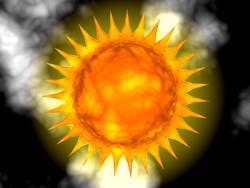Life as a teenager in the 70s consisted of hip-hugger bell-bottom jeans (most recently termed "low rise flare"), feathered hair, disco, 3.2 beer, and laying out in the sun on a reflective silver mat. We put peroxide in our hair to get highlights, and of course applied a full bottle of baby oil. Nothing too harmful, right?
Or so we thought.
Fast forward 17 years to graduation from dental hygiene school and the emergence of what I thought was a pimple on my left nostril. Except I never had problems with acne. Ever.
In dental hygiene school I received an excellent education, and it was reinforced that any abnormality that did not heal in two weeks required a referral to the proper specialist. I was off to my first dermatology appointment one month after beginning my career as a dental hygienist.
“Your diagnosis of basal cell carcinoma is optimal,” said the dermatologist, “It is very, very, rare for this type of cancer to metastasize. However, they do grow and spread locally. So we will want to remove it as soon as possible. The positive is that the lesion is only 2 mm in diameter on the surface. That usually indicates the entire lesion below the surface will also be small and easily removed with the Mohs surgery.”
The Mohs surgery, he explained, required anesthetizing my nose and face via the infraorbital nerve and locally on the left nostril. I remember thinking to myself, "That will be easy," as I had endured local anesthesia in dental hygiene school when we gave our first injections on one another. That thought turned out to be wrong. Childbirth was less painful than that injection.
Continuing to explain the Mohs surgery, the doctor explained that he would remove as small amount of tissue as possible, yet enough to where he thought he could get clear margins all around the lesion and avoid having to “go back in again” to remove remaining cancerous tissue, as that required additional injections to numb the area again and of course remove more of the nose. With a smile he said, “I really believe I’ll be able to remove all of this basal cell carcinoma lesion on the first attempt.”
The day of the surgery I was instructed to arrive at 6:30 a.m. to check in and go through pre-op. I was also instructed to have someone come with me, so of course my amazing mom cheerfully came with me. We never outgrow the need for our mothers—their love, encouragement, and wisdom.
My mom and I arrived early. We were directed to the Mohs surgery waiting area, which was separate from the other waiting area. We walked in, found seats in the already crowded room, a room that was filled with patients who were all older than my mom. As we sat there in the quiet waiting to be called back by the nurse, all I could think was, “How did this happen? Skin cancer at this young age of 36? The dermatologist will be cutting out a piece of my nose...”
At my initial visit with the dermatologist, I remember him asking me where I grew up and what my lifestyle was like growing up. He said I was pretty young to have a skin cancer. I told him I grew up right where we were, in Boulder, Colorado. I started snow skiing at age five and riding horses even before that. I was on a summer swim team from fourth grade through high school. I was a lifeguard. Oh yes, there were also many trips to the beaches of Hawaii. I remember he asked, “Any sunburns on your nose?” Oh yes, too many to count, and some were pretty bad.
That is how this happened.
My mom and I were the last remaining patients at the end of the day. Everyone else had completed their surgeries and gone home. The basal cell carcinoma on my left nostril required the dermatologist to “go in” three times to remove the entire lesion and get clean margins. The hole in my left nostril was so large that the dermatologist recommended I see a plastic surgeon for reconstruction.
Because it was thought that this was a small lesion, I had not had a consult with a plastic surgeon prior to this surgery. The plastic surgeon I was referred to got me in immediately the next day. The reconstruction was horrific, as again they used local anesthetic to anesthetize the area. I left with stitches from just under my left eye to just below my left nostril.
I have had two more Mohs surgeries, 11 years after my first surgery on my right nostril and just three years ago on the top of my nose. With these, I knew what I was in for. I was proactive in preparing for the surgeries and reconstruction. The basal cell carcinoma on my right nostril went into the rim of my nose. This required reconstruction under general anesthesia due to the complexity of rebuilding my nostril. At the same time, the plastic surgeon said he could fix the “not so good reconstruction” done on my left nostril.
As dental hygienists, we are in a prime position to screen our patients for any abnormalities on the face, scalp, and hairline. We are also in the perfect place to direct patients to a dermatologist for evaluation. Remember, always wear your sunscreen!
Related: Skin’s out for the summer: 4 things every RDH needs to know about skin cancer | By Amber Auger, MPH, RDH
